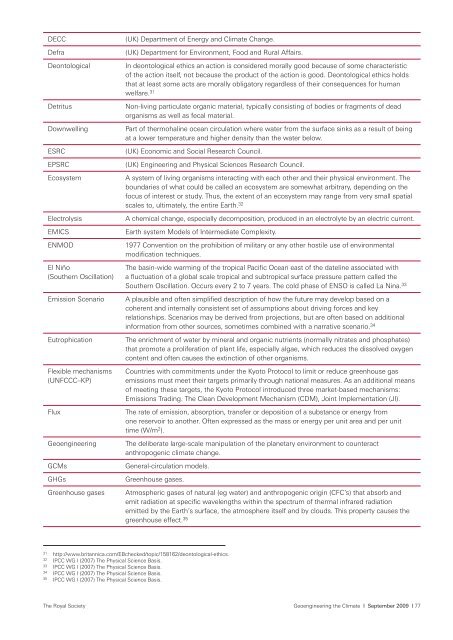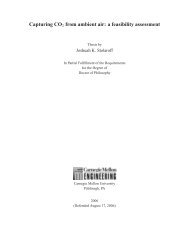Royal Society - David Keith
Royal Society - David Keith
Royal Society - David Keith
Create successful ePaper yourself
Turn your PDF publications into a flip-book with our unique Google optimized e-Paper software.
DECC<br />
Defra<br />
Deontological<br />
Detritus<br />
Downwelling<br />
ESRC<br />
EPSRC<br />
Ecosystem<br />
Electrolysis<br />
EMICS<br />
ENMOD<br />
El Nino<br />
(Southern Oscillation)<br />
Emission Scenario<br />
Eutrophication<br />
Flexible mechanisms<br />
(UNFCCC–KP)<br />
Flux<br />
Geoengineering<br />
GCMs<br />
GHGs<br />
Greenhouse gases<br />
(UK) Department of Energy and Climate Change.<br />
(UK) Department for Environment, Food and Rural Affairs.<br />
In deontological ethics an action is considered morally good because of some characteristic<br />
of the action itself, not because the product of the action is good. Deontological ethics holds<br />
that at least some acts are morally obligatory regardless of their consequences for human<br />
welfare. 31<br />
Non-living particulate organic material, typically consisting of bodies or fragments of dead<br />
organisms as well as fecal material.<br />
Part of thermohaline ocean circulation where water from the surface sinks as a result of being<br />
at a lower temperature and higher density than the water below.<br />
(UK) Economic and Social Research Council.<br />
(UK) Engineering and Physical Sciences Research Council.<br />
A system of living organisms interacting with each other and their physical environment. The<br />
boundaries of what could be called an ecosystem are somewhat arbitrary, depending on the<br />
focus of interest or study. Thus, the extent of an ecosystem may range from very small spatial<br />
scales to, ultimately, the entire Earth. 32<br />
A chemical change, especially decomposition, produced in an electrolyte by an electric current.<br />
Earth system Models of Intermediate Complexity.<br />
1977 Convention on the prohibition of military or any other hostile use of environmental<br />
modification techniques.<br />
The basin-wide warming of the tropical Pacific Ocean east of the dateline associated with<br />
a fluctuation of a global scale tropical and subtropical surface pressure pattern called the<br />
Southern Oscillation. Occurs every 2 to 7 years. The cold phase of ENSO is called La Nina. 33<br />
A plausible and often simplified description of how the future may develop based on a<br />
coherent and internally consistent set of assumptions about driving forces and key<br />
relationships. Scenarios may be derived from projections, but are often based on additional<br />
information from other sources, sometimes combined with a narrative scenario. 34<br />
The enrichment of water by mineral and organic nutrients (normally nitrates and phosphates)<br />
that promote a proliferation of plant life, especially algae, which reduces the dissolved oxygen<br />
content and often causes the extinction of other organisms.<br />
Countries with commitments under the Kyoto Protocol to limit or reduce greenhouse gas<br />
emissions must meet their targets primarily through national measures. As an additional means<br />
of meeting these targets, the Kyoto Protocol introduced three market-based mechanisms:<br />
Emissions Trading. The Clean Development Mechanism (CDM), Joint Implementation (JI).<br />
The rate of emission, absorption, transfer or deposition of a substance or energy from<br />
one reservoir to another. Often expressed as the mass or energy per unit area and per unit<br />
time (W/m 2 ).<br />
The deliberate large-scale manipulation of the planetary environment to counteract<br />
anthropogenic climate change.<br />
General-circulation models.<br />
Greenhouse gases.<br />
Atmospheric gases of natural (eg water) and anthropogenic origin (CFC’s) that absorb and<br />
emit radiation at specific wavelengths within the spectrum of thermal infrared radiation<br />
emitted by the Earth’s surface, the atmosphere itself and by clouds. This property causes the<br />
greenhouse effect. 35<br />
31<br />
http://www.britannica.com/EBchecked/topic/158162/deontological-ethics.<br />
32<br />
IPCC WG I (2007) The Physical Science Basis.<br />
33<br />
IPCC WG I (2007) The Physical Science Basis.<br />
34<br />
IPCC WG I (2007) The Physical Science Basis.<br />
35<br />
IPCC WG I (2007) The Physical Science Basis.<br />
The <strong>Royal</strong> <strong>Society</strong><br />
Geoengineering the Climate I September 2009 I 77








